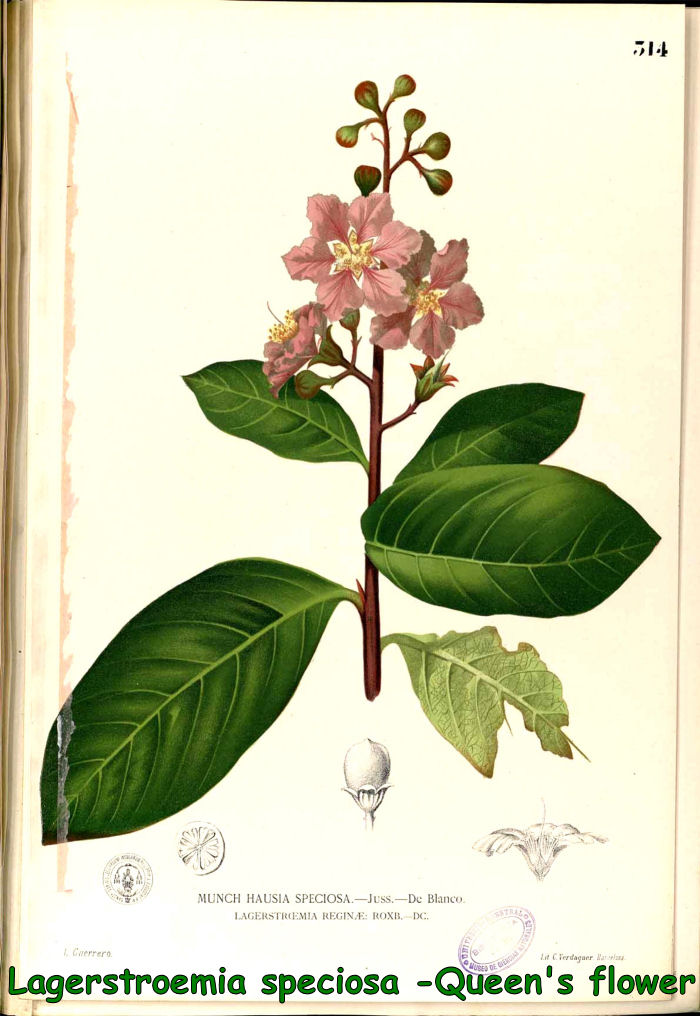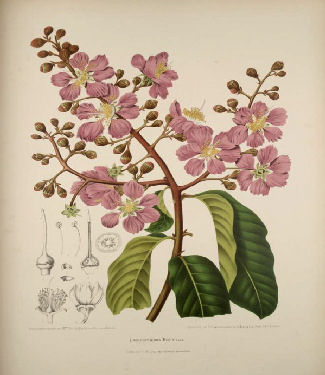 |
 |
LAGERSTROEMIA SPECIOSA L. - QUEEN'S FLOWER. Synonym
SynonymLagerstroemia reginae. Common name Queen's flower, pride of India, queen's crape myrtle, banaba. Family Lythraceae (Loosestrife family). Overview Queen's flower is a deciduous tropical flowering tree growing up to 50 feet tall; it has smooth rounded leaves. The red-orange leaves have higher levels of corosolic acid. The beautiful flowers are racemes and are pink, purple or purplish - pink. The fruit is oval, about one inch long and splits in six pieces when mature; the seeds are small and have winged flaps. The reddish brown wood of Banaba is used for home building, furniture, boats, etc. The Queen's flower will stand out in every garden and is a beautiful landscape tree. Traditional Medicinal Applications The roots are used for stomach problems. Tea of the leaves is used against diabetes mellitus and for weight loss. Banaba leaves are able to lower blood sugar due to, among other phytochemicals; acid (triterpenoid glycoside). This is not the only active phyto-chemical, though. The phytochemicals in the leaves of Banaba works at the molecular level by fine-tuning the damaged insulin receptor, which is the cause of insulin resistance.  Banaba also contains concentrations of dietary fiber and minerals such as magnesium and zinc.
Banaba also contains concentrations of dietary fiber and minerals such as magnesium and zinc.It helps the body handling glucose and is as such also effective in weight loss and against obesity. The hypoglycemic (blood sugar lowering) effect is similar to that of insulin (which induces glucose transport from the blood into body cells). The tea is therapeutic against ailments such as diabetes, kidney- and urinary problems. The taste is pleasant and smooth; in Japan it is known as "slimming tea." Banaba can also be applied against gout (metabolic arthritis); the leaves contain Valoneic Acid Dilactone (VAD). This acts as as an inhibitor of xanthine oxidase to lower uric acid levels. The effect of VAD is stronger than Allopurinol (brand names: Aloprim®, Zyloprim®) and is without the side effects commonly associated with this drug. For best results, use together with exercise and diet. Visit our APPLICATION & DOSAGE -, CHOLESTEROL -, DIABETES - , GOUT - , HYPERTENSION - and TINCTURE pages. Hardiness USDA zone 9B - 11. Propagation Seeds. Culture Full sun; can be planted on most soils but it has low salt tolerance. Plant in a frost free location or protect from frost. |
For the right freight rate, shipping charges, conditions and delivery service, please visit our Webstore page! |